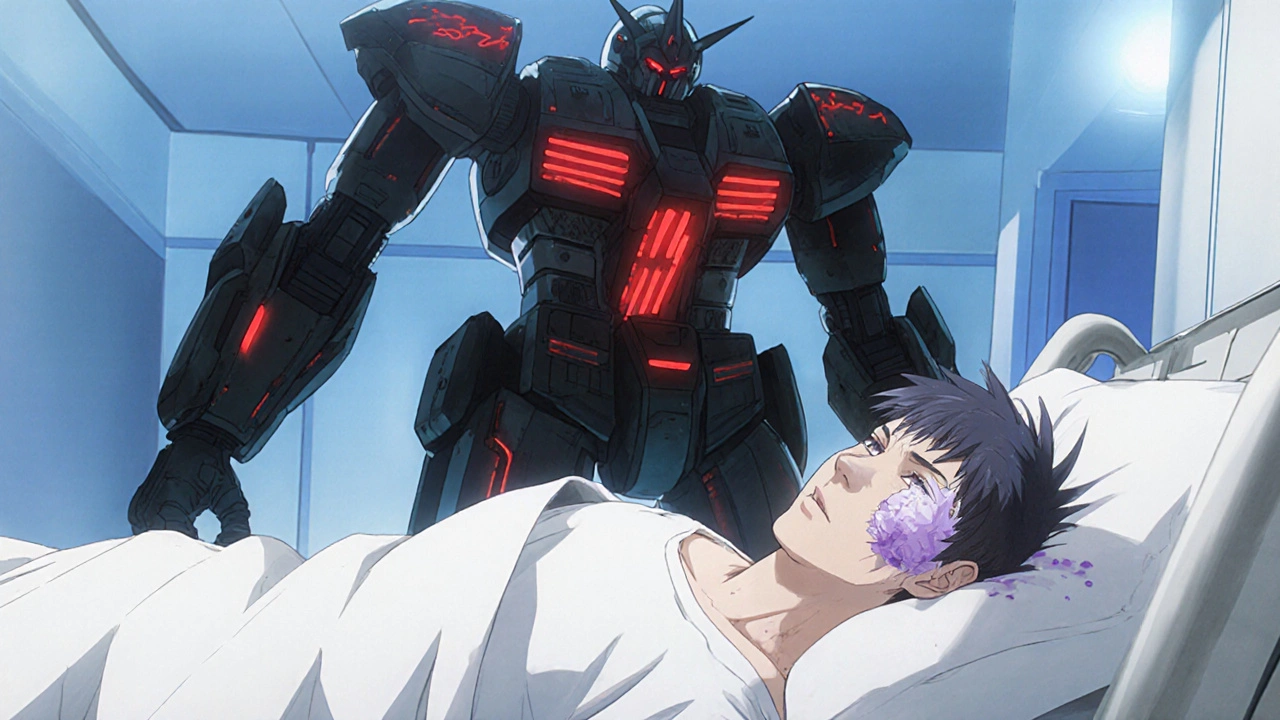Drug-Induced TTP Risk Calculator
Clinical Features Assessment
Risk Assessment
Thrombotic Thrombocytopenic Purpura (TTP) is a rare, life‑threatening disorder marked by severe platelet loss, fragmented red cells, and multi‑organ injury. When certain drugs trigger the cascade, the condition becomes a medical emergency that can explode within days of exposure.
Imagine a patient who started a new antiplatelet drug and, after a week, develops bruises, confusion, and a platelet count that drops below 20 ×10⁹/L. If the team thinks it’s just a side‑effect or an infection, precious hours are lost, and mortality climbs to 10‑20 % even with treatment. This article walks you through the exact steps to recognize, diagnose, and manage drug-induced thrombotic thrombocytopenic purpura, so you can act before the reaction becomes fatal.
What Makes TTP Different When a Drug Is Involved?
Classic TTP stems from a severe deficiency of the metalloprotease ADAMTS13, which normally chops ultra‑large von Willebrand factor (vWF) multimers. Without enough ADAMTS13, clots form in tiny vessels, shredding red cells and sucking up platelets. In drug‑induced cases two mechanisms dominate:
- Immune‑mediated: The drug acts as a hapten, prompting antibodies that only bind platelets when the drug is present. This explains why patients can have high antibody titres for years but stay symptom‑free until re‑exposure.
- Dose‑dependent toxicity: Certain agents (e.g., mitomycin C, cyclosporine) directly damage endothelial cells. Toxicity builds with cumulative exposure and usually appears after months of therapy.
Both pathways end with the same clinical picture, but they differ in timing, lab clues, and response to plasma exchange.
Drugs Most Frequently Implicated
More than 50 drugs have been linked to TTP, but evidence of causality is strongest for about 20. The biggest culprits, based on level‑1 data, include:
- Quinine (often hidden in “bitter lemon” tonic water)
- Ticlopidine
- Clopidogrel
- Cyclosporine
- Mitomycin C
- Newer biologics such as adalimumab and golimumab (≈5 % of recent reports)
Clinicians should also keep an eye on antibiotics (e.g., fluoroquinolones), anti‑VEGF agents, and checkpoint inhibitors, which have surfaced in case series after 2020.
Red‑Flag Clinical Features
Drug‑induced TTP typically presents within 1-14 days for immune‑mediated triggers and 6-12 months for dose‑dependent toxins. Look for the classic pentad, but remember that not all five signs appear together:
- Severe thrombocytopenia (<150 ×10⁹/L, often <50 ×10⁹/L)
- Microangiopathic hemolytic anemia (schistocytes on smear, LDH > 500 U/L, undetectable haptoglobin)
- Neurological symptoms (confusion, seizures, headache)
- Renal dysfunction (rising creatinine, oliguria)
- Fever (less common, may be absent)
When these appear shortly after a new medication, the suspicion should jump to the top of the differential.
Diagnostic Algorithm at a Glance
| Feature | Immune‑Mediated | Dose‑Dependent Toxicity |
|---|---|---|
| Typical latency | Days (median 7‑14) | Months (6‑12) of continuous exposure |
| Platelet nadir | Very low (<20 ×10⁹/L) | Moderate‑low (30‑80 ×10⁹/L) |
| ADAMTS13 activity | <10 % (often with inhibitor) | Normal or mildly reduced |
| Response to plasma exchange | Excellent (>80 % rapid platelet rise) | Limited; discontinuation is key |
| Key drugs | Quinine, clopidogrel, ticlopidine | Cyclosporine, mitomycin C, high‑dose chemotherapy |
Step‑by‑step, the algorithm looks like this:
- Obtain a thorough medication list, including over‑the‑counter and supplements.
- Order CBC with peripheral smear, LDH, haptoglobin, creatinine, and a STAT ADAMTS13 activity assay.
- Exclude alternative causes (e.g., sepsis, disseminated intravascular coagulation, Heparin‑induced thrombocytopenia).
- If ADAMTS13 < 10 % or a high‑risk drug was started < 14 days ago, treat as immune‑mediated TTP.
- For toxic‑dose cases, focus on drug cessation and organ‑supportive care.

First‑Line Treatment: What to Do in the First Hours
Time is the most critical factor. The American Society of Hematology (2021) recommends:
- Immediate drug discontinuation. Platelet counts often begin to rise within 24‑48 hours once the offending agent is stopped.
- Plasma exchange (PEX) for suspected immune‑mediated cases. Initiate within 4‑8 hours of diagnosis, exchanging 1.5 × patient plasma volumes daily until two consecutive platelet readings exceed 150 ×10⁹/L.
- Adjunctive corticosteroids (e.g., methylprednisolone 1 mg/kg) to blunt the antibody response.
- Caplacizumab (anti‑vWF nanobody) for patients who meet criteria for severe immune‑mediated TTP; the TITAN trial showed a 78 % reduction in time to platelet normalization.
For dose‑dependent toxicity, the evidence for PEX is weak. Focus on stopping the drug, providing renal replacement therapy if needed, and supportive transfusions. Some centres use rituximab for refractory immune‑mediated cases, but data remain limited.
Monitoring and When to De‑Escalate
After the initial surge of PEX, labs should be drawn daily:
- Platelet count - aim for >150 ×10⁹/L for two days before stopping PEX.
- LDH - should trend down; persistent elevation may signal ongoing micro‑thrombosis.
- ADAMTS13 - repeat after 7 days to confirm inhibitor clearance.
If platelet recovery stalls after three days of PEX, consider adding rituximab or switching to caplacizumab. Remember that drug‑dependent antibodies can linger; re‑exposure to the culprit will reignite the process within hours.
Prevention Strategies for Clinicians and Patients
Most drug‑induced TTP cases could be avoided with a systematic approach:
- Implement a “high‑risk medication checklist” during every new prescription - flag quinine, clopidogrel, ticlopidine, cyclosporine, mitomycin C, and newer biologics.
- Educate patients about warning signs (easy bruising, dark urine, sudden confusion) and the need to report them immediately.
- For drugs with known dose‑dependency, schedule regular CBCs and renal panels every 4‑6 weeks.
- Document any prior drug‑induced TTP episodes in the electronic health record; many adverse‑event databases now auto‑alert prescribers.
- Encourage pharmacists to double‑check for quinine‑containing over‑the‑counter products, especially “bitter lemon” tonic water.
In practice, a simple two‑question screen ("Have you started any new medication or supplement in the past two weeks?" and "Any unexplained bruising or fatigue?") can catch most early cases.

Current Research and Future Directions
Even with modern plasma exchange, mortality has plateaued around 15 %. Emerging therapies aim to close that gap:
- Caplacizumab - now in guidelines for severe immune‑mediated TTP; cost remains a barrier (<$18,500 per treatment course).
- Rapid point‑of‑care ADAMTS13 assays - the European Hematology Association is piloting bedside kits that deliver results in under an hour.
- Genetic risk profiling - early GWAS data link HLA‑DRB1*11:01 to quinine‑induced TTP, suggesting a future for pre‑emptive testing.
- Drug development pipelines now include mandatory endothelial toxicity screens, reducing the chances of new agents slipping through unnoticed.
For patients, the real advance will be faster diagnosis and more affordable targeted drugs that stop the clotting cascade without the need for daily plasma exchanges.
Key Takeaways
- Drug‑induced TTP is a medical emergency; suspect it within days of a new high‑risk medication.
- Immune‑mediated cases respond dramatically to plasma exchange and steroids; dose‑dependent cases rely on drug cessation.
- Early laboratory work (CBC, smear, LDH, ADAMTS13) guides therapy, but never delay treatment while awaiting results.
- Prevention hinges on medication reconciliation, patient education, and routine monitoring for known culprits.
- New therapies like caplacizumab and rapid ADAMTS13 testing promise better outcomes, but access and cost remain challenges.
Frequently Asked Questions
What is the difference between TTP and HUS?
Both are thrombotic microangiopathies, but TTP is driven mainly by severe ADAMTS13 deficiency, leading to widespread platelet clumping, whereas HUS usually follows a Shiga‑toxin infection and is characterized by prominent kidney injury.
Can over‑the‑counter supplements cause TTP?
Yes. Quinine, often found in “bitter lemon” tonic water and some herbal remedies, has a well‑documented link to immune‑mediated TTP even at low doses.
How fast does plasma exchange work?
In immune‑mediated drug‑induced TTP, platelet counts typically rise above 50 ×10⁹/L within 48 hours of starting daily plasma exchange, and reach safe levels (>150 ×10⁹/L) in 4-7 days.
Is caplacizumab approved for drug‑induced TTP?
The FDA approved caplacizumab for acquired TTP in 2019. Guidelines now recommend it as an adjunct to plasma exchange for severe immune‑mediated cases, including those triggered by medications.
What labs confirm drug‑dependent antibodies?
Specialized assays performed at reference centers (e.g., the Oklahoma University Platelet Immunology Lab) detect antibodies that bind platelets only in the presence of the suspected drug. A positive result is level‑1 evidence for causality.
Recognizing drug‑induced TTP early, stopping the offending agent, and initiating plasma exchange can turn a potentially fatal cascade into a treatable condition. Stay vigilant, ask the right questions, and keep the diagnostic work‑up moving-every hour counts.


Joy Dua
October 26, 2025 AT 18:20The precipitous fall in platelets accompanied by fragmented erythrocytes within days of a new medication is a diagnostic red flag that mandates urgent ADAMTS13 assay and plasma exchange. In drug‑induced TTP the temporal association often eclipses other differentials and should dominate the clinician’s algorithm.
Holly Kress
October 26, 2025 AT 18:30Absolutely, early recognition saves lives and a clear protocol can guide the team through the urgency without hesitation. Providing a quick reference sheet on the classic pentad and drug culprits can empower bedside staff.
Charlene Gabriel
October 26, 2025 AT 19:10Drug‑induced TTP remains a daunting emergency because its onset can masquerade as a simple adverse drug reaction.
The first step after suspicion is to halt the offending agent without delay.
Concurrently draw a peripheral smear, complete blood count, LDH, bilirubin, and renal panel while notifying the transfusion service.
An ADAMTS13 activity level below 10 % strongly supports the diagnosis, but therapy should not await the result.
Initiate daily therapeutic plasma exchange with fresh frozen plasma as soon as the machine is available.
Steroid pulses, commonly methylprednisolone 1 g daily, are added to dampen the immune response in antibody‑mediated cases.
If the patient shows neurologic decline despite plasma exchange, consider adjunctive rituximab to target the pathogenic clone.
For dose‑dependent toxicities, dose reduction or drug discontinuation is paramount, but plasma exchange still offers benefit by removing circulating ultralarge vWF multimers.
Monitor platelet trends every 6 hours; a doubling of the count often heralds a favorable response.
Red blood cell transfusions should be reserved for symptomatic anemia because they can exacerbate microvascular occlusion.
Renal function requires close observation; in severe acute kidney injury dialysis may be necessary while the underlying process resolves.
Once platelet counts stabilize above 150 × 10⁹/L for two consecutive days, taper plasma exchange gradually.
Long‑term follow‑up includes periodic ADAMTS13 activity testing to detect relapse before clinical deterioration.
Patients who have experienced drug‑induced TTP should receive comprehensive counseling on drug avoidance and carry medical alert identification.
In institutions lacking immediate plasma‑exchange capability, rapid transfer to a tertiary center is the safest option.
Ultimately, a multidisciplinary approach involving hematology, nephrology, neurology, and critical care ensures the best chance for survival and recovery.
renee granados
October 26, 2025 AT 19:20These protocols look clean but pharma pushes these drugs fearing profit they hide side‑effects we need real transparency.
Stephen Lenzovich
October 26, 2025 AT 20:33Only the best American hospitals can handle such crises with speed and precision.
abidemi adekitan
October 26, 2025 AT 20:43Indeed, the infrastructural prowess of U.S. centers facilitates rapid plasma exchange, but sharing best practices globally can uplift outcomes everywhere.
Barbara Ventura
October 26, 2025 AT 23:20Wow, the article really breaks down the whole process, from the subtle bruise to the massive plasma exchange, and it does so in a way that’s both thorough, and accessible, and surprisingly engaging.
Ramesh Kumar
October 26, 2025 AT 23:30Adding to that, remember that the efficacy of plasma exchange hinges on replacing at least 1.5 plasma volumes per session, which maximizes clearance of pathogenic vWF multimers and antibodies.